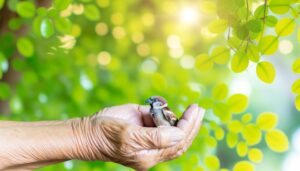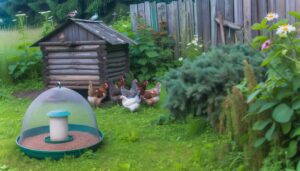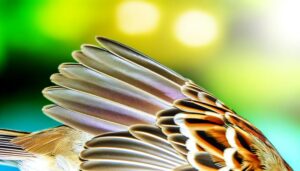Do Baby Sparrows Eat Flies?
Baby sparrows consume a diet rich in small insects, including flies, to satisfy their substantial nutritional requirements during development. Initially, they receive partially digested food from their parents but shift to solid food, with insects forming a vital part of their diet.
This insect-based intake provides essential proteins and vitamins like A, D, E, and K, critical for growth, immune function, and development of muscles, feathers, and bones. Parental feeding behaviors are finely tuned to deliver nutrient-rich prey, ensuring survival and best growth.
Understanding these dietary habits offers deeper insights into the complex feeding strategies of these avian nestlings.
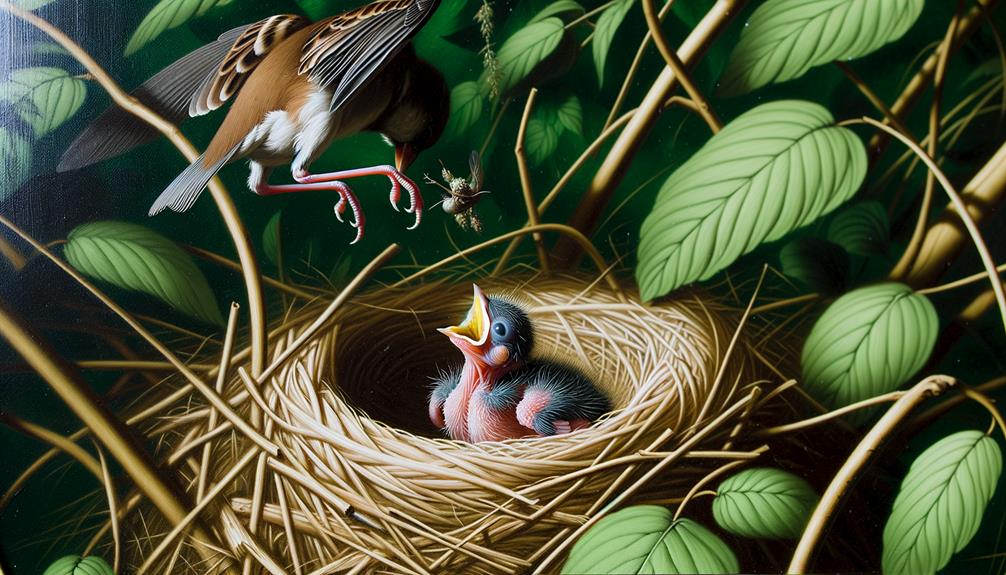
Key Takeaways
- Baby sparrows consume flies as a crucial source of protein and nutrients.
- Insects like flies are vital for the growth and development of nestling sparrows.
- Parental sparrows actively hunt flies to feed their young.
- Flies provide essential amino acids and micronutrients for muscle and feather development.
- An insect-based diet, including flies, ensures baby sparrows receive necessary nutrients.
Feeding Habits of Baby Sparrows
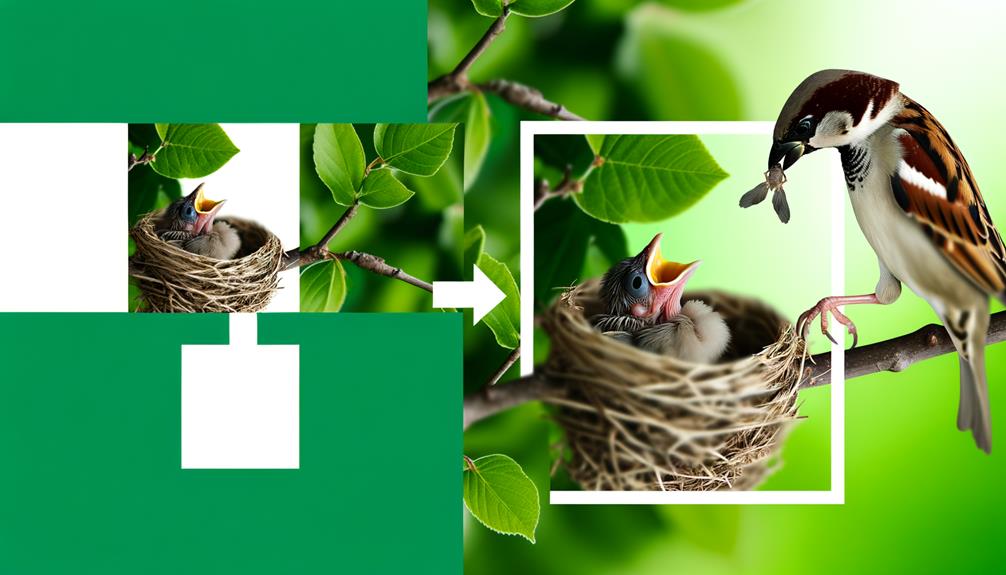
How do the feeding habits of baby sparrows adapt to their nutritional needs and developmental stages?
Baby sparrows, or nestlings, exhibit specific feeding behaviors that evolve as they grow. Initially, parents provide regurgitated, partially digested food, which is easier for the nestlings to consume and assimilate. This stage is critical for guaranteeing they receive adequate moisture and nutrients essential for rapid growth and development.
As their digestive systems mature, nestlings begin to receive more solid food, including small insects like flies. This gradual change to solid food helps develop their digestive efficiency and prepares them for independent foraging.
Such adaptive feeding strategies guarantee that the nestlings' evolving nutritional requirements are met, facilitating prime growth and survival.
Nutritional Needs of Nestlings
Understanding the nutritional needs of sparrow nestlings is pivotal for their development. This includes considerations such as protein requirements, essential vitamins, and feeding frequency.
Protein is a fundamental component for growth and tissue repair, which nestlings obtain primarily through insect consumption, including flies.
Adequate vitamin intake is necessary for metabolic processes.
The frequency of feeding plays a significant role in ensuring consistent nutrient availability.
Protein Requirements
Meeting the protein needs of nestling sparrows is crucial for their growth, development, and overall survival. Protein serves as a fundamental building block for muscle, feather, and organ development. The dietary needs of nestlings are particularly high, requiring a diverse array of protein sources. Flies and other insects provide a readily available and nutrient-rich option.
Key reasons for the high protein demands include:
- Rapid Growth: Nestlings experience accelerated growth rates, necessitating significant protein intake.
- Feather Development: Protein is crucial for the development of strong, functional feathers, which are essential for future flight.
- Immune Function: Adequate protein supports a robust immune system, enhancing the nestling's ability to fend off diseases.
Understanding these requirements ensures optimal nutrition and survival rates in baby sparrows.
Vitamin Sources
In addition to their protein needs, nestling sparrows require a consistent supply of vitamins to support their metabolic processes, growth, and overall health. Vitamins A, D, E, and K are essential for these young birds. Vitamin A aids in vision and immune function, while Vitamin D is vital for calcium absorption and bone development. Vitamin E acts as an antioxidant, protecting cells from damage, and Vitamin K is significant for blood clotting. A well-rounded diet incorporating diverse food sources guarantees these vitamins are available in sufficient quantities.
| Vitamin | Function | Source |
|---|---|---|
| A | Vision, immune function | Insects, leafy greens |
| D | Calcium absorption, bone health | Sunlight exposure, insects |
| E | Antioxidant, cell protection | Seeds, plant oils |
This inclusive approach ensures nestlings receive a balanced diet.
Feeding Frequency
Determining the best feeding frequency for nestling sparrows is crucial to guarantee their rapid growth and proper development. Research indicates that the nutritional needs of these young birds are highly demanding.
Key considerations include:
- Frequency: Nestling sparrows require feeding every 15-20 minutes during daylight to fulfill their metabolic needs.
- Volume: Each feeding should involve a small quantity of nutrient-rich food, approximately 10% of the nestling's body weight.
- Consistency: Regular, consistent feeding schedules help prevent malnutrition and developmental delays.
Studies show that inadequate feeding frequencies can lead to stunted growth and weakened immune systems. Hence, following these guidelines guarantees that nestling sparrows receive the essential nutrients necessary for their survival and thriving development.
Insect Consumption in Sparrows
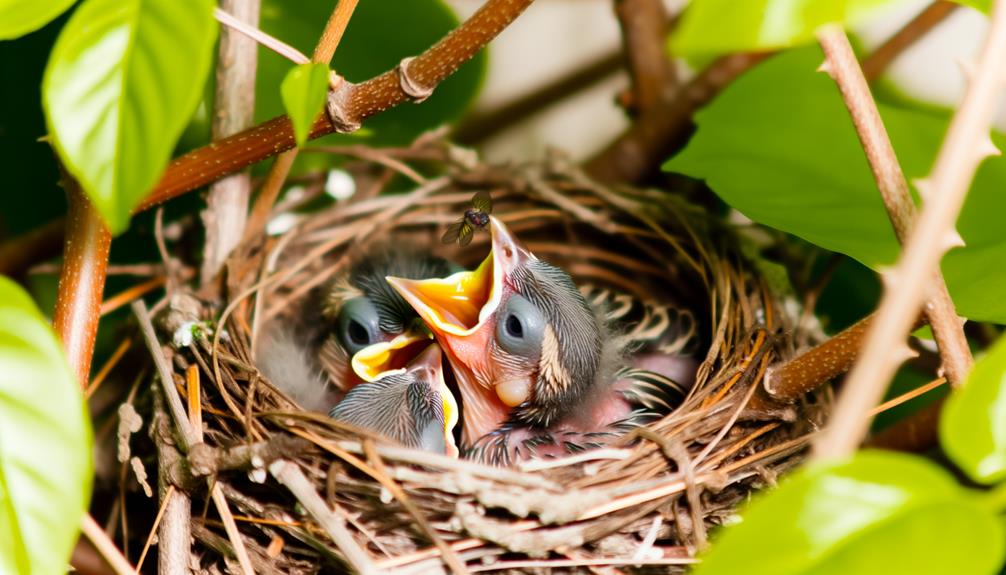
Sparrows, particularly during their early developmental stages, demonstrate a marked preference for consuming various species of insects, including flies, as a critical component of their diet. This inclination towards insects is driven by the need for essential nutrients that are crucial for growth. Observational studies reveal that adult sparrows actively hunt and feed their young various insects, ensuring an adequate supply of proteins and other necessary nutrients. The table below provides an overview of common insects consumed by sparrows and their nutritional benefits:
| Insect Species | Nutritional Benefit |
|---|---|
| Flies | High in protein and fat |
| Beetles | Rich in minerals and fiber |
| Caterpillars | Source of essential amino acids |
These dietary choices underscore the importance of insects in fostering ideal development in young sparrows.
Role of Protein in Growth
Proteins play a vital role in the growth and development of young sparrows. They serve as fundamental building blocks for muscle formation, cellular repair, and overall physiological function. Adequate protein intake is essential for the following reasons:
- Muscle Development: Proteins provide the amino acids necessary for the synthesis of new muscle tissues, pivotal for fledging and flight.
- Cellular Repair: Proteins are integral to the repair of damaged cells, ensuring swift recovery and maintenance of healthy tissues.
- Metabolic Processes: Proteins are involved in enzymatic activities that regulate metabolic processes essential for energy production and nutrient assimilation.
Parental Feeding Behaviors
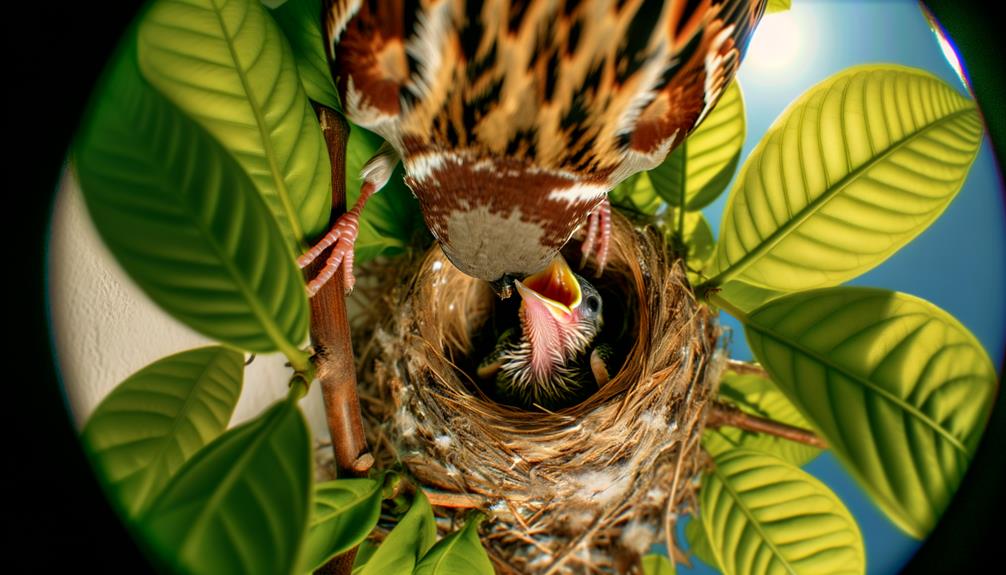
Understanding the significance of protein for the growth of baby sparrows, it becomes clear that parental feeding behaviors are carefully adapted to guarantee the delivery of nutrient-rich prey, such as flies, to their offspring. Adult sparrows exhibit sharp foraging behaviors, selectively capturing insects that provide essential amino acids required for nestling growth. These behaviors are driven by innate and learned mechanisms ensuring the best nutritional intake for their young. The following table illustrates the feeding frequency, prey selection, and nutritional intake observed in sparrow families:
| Feeding Frequency | Preferred Prey | Nutritional Benefits |
|---|---|---|
| 6-8 times per hour | Flies | High protein content |
| 4-6 times per hour | Beetles | Essential minerals |
| 3-5 times per hour | Caterpillars | High fat content |
| 2-4 times per hour | Spiders | Essential nutrients |
| 1-3 times per hour | Ants | Protein and fats |
These behaviors ensure the survival and growth of the offspring.
Common Prey for Nestlings
Nestling sparrows mainly consume an insect-based diet, which is crucial for meeting their high protein and energy requirements during early development stages.
Flies, along with other small insects, provide essential nutrients such as amino acids, fatty acids, and micronutrients necessary for best growth and feather development.
Understanding the specific prey composition and its nutritional benefits can offer insights into the dietary strategies employed by sparrow parents to guarantee the survival and health of their offspring.
Insect-Based Diet
Insect-based diets, particularly those rich in flies, provide necessary nutrients that are required for the growth and development of baby sparrows. These insects are a crucial component of nestling nutrition, offering high protein content and other bioavailable nutrients.
Specifically, baby sparrows commonly consume:
- House Flies (Musca domestica): Abundant and easy to catch, house flies are a prime source of protein.
- Fruit Flies (Drosophila spp.): These smaller insects are nutrient-dense and easily digestible for young sparrows.
- Mosquitoes (Culicidae): Though less commonly observed, mosquitoes also contribute essential nutrients.
Each type of prey plays a pivotal role in the early dietary regime of sparrow nestlings, ensuring they receive a balanced intake of proteins and other crucial nutrients needed for optimal development.
Nutritional Needs
The nutritional needs of baby sparrows are met through a diverse array of prey, each offering unique and important nutrients that contribute to their rapid growth and developmental success. Among the common prey items, flies are rich in protein and fats, which are vital for muscle development and energy.
Additionally, caterpillars provide high levels of carotenoids and other pigments essential for plumage coloration. Beetles and spiders offer chitin, aiding in digestive health. Ants and aphids are also consumed, delivering essential amino acids and minerals.
This varied diet ensures that nestlings receive a balanced intake of nutrients, facilitating best physiological development and preparing them for fledging. Understanding these dietary patterns is crucial in avian developmental biology and conservation efforts.
Are Flies on the Menu?
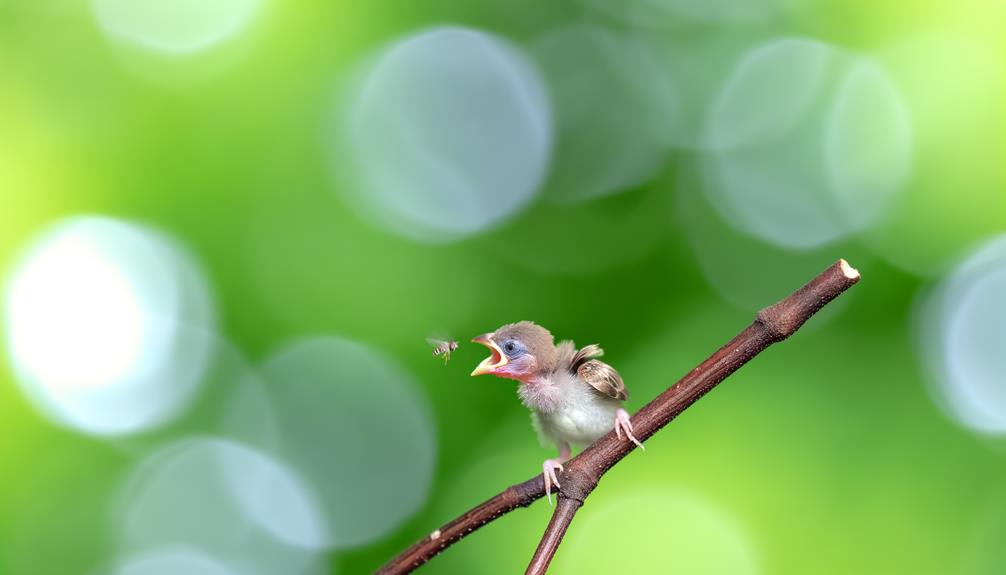
While sparrows are mainly seed eaters, their diet can become more varied during the nesting period, often incorporating a significant number of insects, including flies, to meet the nutritional demands of their growing chicks. This dietary shift is important for several reasons:
- Protein Content: Flies are rich in protein, which is vital for the rapid growth and development of baby sparrows.
- Ease of Digestion: Insects like flies are easier for young birds to digest compared to seeds, reducing the risk of digestive issues.
- Availability: During spring and summer, flies are abundant and readily accessible, making them an available food source.
These factors underscore the adaptability of sparrows in optimizing their diet to guarantee the survival and health of their offspring.
Comparison With Adult Diets
The dietary requirements of baby sparrows exhibit significant differences from those of adult sparrows, primarily due to varying nutritional needs during development.
While juvenile sparrows rely heavily on high-protein sources such as flies to support rapid growth and feather development, adults consume a more diverse diet that includes seeds, grains, and occasional insects to maintain energy levels.
This shift in feeding patterns underscores the importance of specific nutrients at different life stages and reflects adaptive strategies for survival and growth.
Nutritional Needs Variability
Juvenile sparrows exhibit distinct nutritional needs that differ significantly from those of adult sparrows, necessitating a diet specifically rich in protein sources such as flies to support their rapid growth and development. Unlike adults, which can subsist on a more varied diet including seeds and grains, baby sparrows require:
- High Protein Intake: Essential for muscle development and feather growth.
- Frequent Feeding: Due to their smaller stomachs and higher metabolic rates.
- Nutrient Density: Concentrated nutrients are crucial for supporting their accelerated physiological changes.
These dietary needs underscore the importance of protein-rich insects, which provide the necessary amino acids and energy. As juveniles mature, their diet gradually shifts to resemble that of adult sparrows, reflecting their changing metabolic and nutritional needs.
Insect Consumption Differences
How do the insect consumption patterns of juvenile sparrows compare to those of adult sparrows, especially when considering nutritional demands and dietary preferences?
Juvenile sparrows exhibit a pronounced inclination towards consuming a higher proportion of insects, particularly flies, due to their elevated protein and energy requirements necessary for rapid growth and development. This protein-rich diet aids in muscle formation and feather development.
In contrast, adult sparrows have a more varied diet, integrating seeds, grains, and plant matter, alongside insects. The shift in dietary preference reflects a reduced need for high-protein intake and an adaptation to broader ecological niches.
The dietary diversification in adults also underscores their ability to exploit different food resources, thereby enhancing survival prospects in fluctuating environments.
Developmental Feeding Patterns
In examining developmental feeding patterns, it becomes clear that young sparrows prioritize a diet rich in insects, particularly flies, to meet their heightened nutritional demands, which starkly contrasts with the more omnivorous feeding habits observed in adult sparrows.
This dietary focus during early stages is essential for several reasons:
- Protein Requirement: Growing sparrows require a high protein intake to support rapid growth and development of feathers and muscles.
- Energy Needs: Insect consumption provides the necessary energy for fledgling sparrows to sustain their high metabolic rates.
- Digestive Efficiency: Young sparrows have digestive systems optimized for processing protein-rich insects rather than the mixed diet of seeds, fruits, and insects consumed by adult sparrows.
Understanding these distinctions is crucial for comprehending avian nutritional ecology.
Seasonal Variations in Diet

Seasonal variations greatly influence the dietary preferences of baby sparrows, with shifts in available food sources leading to adaptations in their feeding behavior.
During spring and summer, an abundance of insects, including flies, caterpillars, and beetles, provides a protein-rich diet essential for their rapid growth and development.
Conversely, in autumn and winter, when insect populations decline, baby sparrows may rely more on seeds and grains, which are more abundant and accessible.
These dietary shifts are vital for their survival, as the nutritional requirements of growing sparrows necessitate high protein intake during early stages, while later stages may accommodate carbohydrate-rich seeds.
Understanding these seasonal dietary adaptations is important for comprehending the ecological dynamics influencing sparrow populations.
Human Impact on Food Sources
The dietary adaptations of baby sparrows are further complicated by human activities, which change the availability and quality of their food sources to a large extent. Urbanization and agricultural expansion have drastically altered natural habitats, directly impacting insect populations that baby sparrows rely on.
Key human-induced changes include:
- Pesticide Use: Agricultural chemicals reduce insect numbers, limiting protein-rich food for nestlings.
- Pollution: Contaminants in the environment can affect the health and quality of available insects.
- Habitat Destruction: Urban sprawl and deforestation lead to a loss of natural foraging grounds.
These factors collectively challenge the ability of baby sparrows to find adequate nutrition, emphasizing the need for conservation efforts to mitigate human impact on their ecosystems.
Conclusion
In summation, the dietary intricacies of baby sparrows unveil a complex tapestry woven with threads of nutritional necessity and ecological adaptability.
While nestlings primarily consume a protein-rich diet of insects, including flies, their sustenance is meticulously curated by parental foraging behaviors.
This dynamic interplay guarantees excellent growth and development, mirroring broader ecological interdependencies.
Such dietary patterns, influenced by seasonal variations and human activities, underscore the delicate balance within avian ecosystems, highlighting the critical role of insect consumption in fledgling survival.



